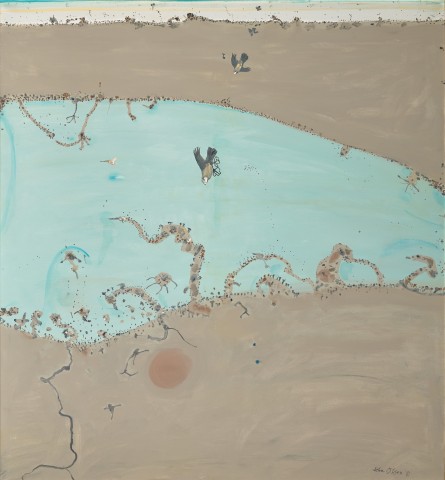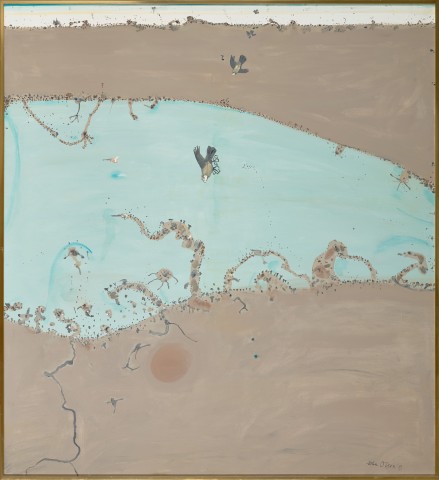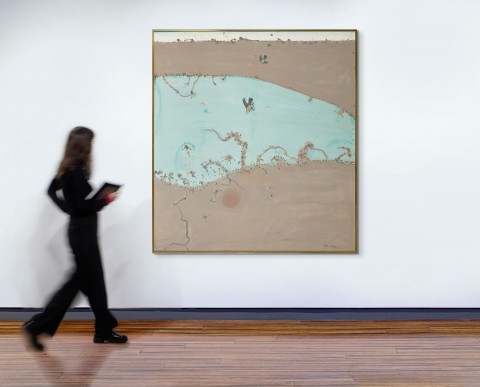HAY, HELL AND BOOLIGAL, 1981
JOHN OLSEN
oil on canvas
182.0 x 166.0 cm
signed and dated lower right: John Olsen ‘81
Rudy Komon Gallery, Sydney (label attached verso)
Private collection, Sydney, acquired in 1982
We are grateful to Kylie Norton, Editor, John Olsen Catalogue Raisonné, for her assistance with this catalogue entry.
From the pulsating energy of his You Beaut Country series, to the quieter, more metaphysical paintings inspired by his expeditions to Lake Eyre, or the exquisitely lyrical works immortalising his halcyon days in Clarendon, Olsen’s unique interpretations of the natural environment in its manifold moods have become indelibly etched on the national psyche. Embracing both figuration and abstraction, his signature technique fusing painting and drawing as one reveals the hand and eye of the artist with every stroke – the act of creation thus imbuing the painted surface with a powerful sense of the artist’s own exuberant energy and palpable joie de vivre. As Deborah Hart, curator and author of several authoritative publications on the artist, asserts, ‘Olsen has confronted and helped redefine our basic conception of landscape… providing a psychological encounter with place, not only as seen but as experienced, resulting in a fresh, exhilarating vision.’1
Painted in the first half of 1981 when Olsen was still working in a studio at the Riverina College of Advanced Education, Wagga Wagga, Hay, Hell and Booligal, 1981 demonstrates well his remarkable ability to capture both the immensity and intricacy of the Australian landscape. Depicting the drought-ravaged Riverina area of south-western New South Wales, the work notably derives its title from the figurative Australian vernacular expression to denote ‘a place of the greatest imaginable heat and discomfort’ – a phrase subsequently popularised by Banjo Paterson in his controversial poem, ‘Hay and Hell and Booligal’, first published in The Bulletin on 25 April 1896. Comparing Booligal unfavourably with the nearby town of Hay, and even Hell itself, the bush poet recounts a litany of problems with the township – from heat, sand, dust and flies to rabbits, mosquitoes, snakes and drought – all with characteristic irreverence and humorous intent which no doubt would have appealed to Olsen, himself an irrepressible larrikin. As the poem concludes:
“We'd have to stop!” With bated breath
We prayed that both in life and death
Our fate in other lines might fall:
“Oh, send us to our just reward
In Hay or Hell, but, gracious Lord,
Deliver us from Booligal!”
Significantly, Olsen first encountered the landscape of the Riverina as a teenager during pre-war family expeditions to Yass, Camden and Tingha.2 Later in 1958, writing in the introduction to the Macquarie Galleries exhibition of works produced during his Spanish sojourn, he would again ponder the region and how to immortalise it in paint: ‘…Questions come to mind: What is it like to get a totality of the Riverina, the Dead Heart and other parts of our wonderful landscape – to travel through, to feel the rise and the fall of hill and plain, to circumvent and come back to where I have been before? I cannot help thinking of Klee’s lead when he said: ‘The line goes for a holiday…’’3
Employing his signature ‘all-at-once’, multi-perspective approach – ‘I’m down on the canvas one moment and flying up the next or looking sideways or underneath’4 – Hay, Hell and Booligal illustrates how tangibly Olsen would eventually capture the sight as well as the feel of this sparse, arid terrain. Map-like, the aerial view details the solid but sinuous form of the river meandering through the open plains, yet as the eye ascends upwards through the picture plane it is brought back to reality by the illusion of depth suggested in the conventional horizon line and pale sky beyond. Even within this expansive scene however, importantly Olsen still incorporates delightful details of the local birdlife, thus encouraging the viewer to appreciate the relationship between the tiny and the vast, the microcosm and macrocosm. Betraying striking affinities with the artist’s iconic depictions of Lake Eyre from the previous decade, indeed the composition is Olsen at his best – eloquently encapsulating his aspirations to express a total landscape experience in his art. As Olsen mused, ‘[only] then you begin to somehow see the wholeness… It’s more than the present, it's the past and projects itself into the future.’5
1. Hart, D., John Olsen, Craftsman House, Sydney, 2000, p. 207
2. Bungey, D., John Olsen: An Artist’s Life, ABC Books, Sydney, 2014, pp. 31 – 36
3. See John Olsen, Macquarie Galleries, Sydney, 1958, n.p.
4. Olsen quoted in Hawley, J., ‘John Olsen’, Encounters with Australian Artists, University of Queensland Press, Queensland, 1993, p. 129
5. Hurlston, D. & Edwards, D. (eds.), John Olsen – The You Beaut Country, National Gallery of Victoria, Melbourne, 2016, p. 10
VERONICA ANGELATOS


